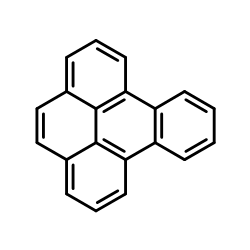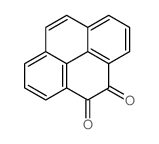192-97-2
| Name | benzo[e]pyrene |
|---|---|
| Synonyms |
4,5-Benzopyrene
1,2-Benzpyrene,4,5-Benzpyrene EINECS 205-892-7 Benzo[l]pyrene MFCD00003605 9,10-Benzpyrene Benzo(a)pyrene benzo<e>pyrene Benzo(l)pyrene Benzo(e)pyrene Benzo[e]pyrene B(e)P 4,5-BENZPYRENE benz[e]pyrene 1,2-Benzopyrene 1,2-Benzpyrene |
| Description | Benzo[e]pyrene occurs in fossil fuels and is a highly toxic member of a family of compounds called polyaromatic hydrocarbons (PAHs)[1]. |
|---|---|
| Related Catalog | |
| References |
| Density | 1.3±0.1 g/cm3 |
|---|---|
| Boiling Point | 467.5±12.0 °C at 760 mmHg |
| Melting Point | 177-180ºC(lit.) |
| Molecular Formula | C20H12 |
| Molecular Weight | 252.309 |
| Flash Point | 228.6±13.7 °C |
| Exact Mass | 252.093903 |
| LogP | 6.40 |
| Vapour Pressure | 0.0±0.6 mmHg at 25°C |
| Index of Refraction | 1.887 |
CHEMICAL IDENTIFICATION
HEALTH HAZARD DATAACUTE TOXICITY DATA
MUTATION DATA
|
| Symbol |


GHS08, GHS09 |
|---|---|
| Signal Word | Danger |
| Hazard Statements | H350-H410 |
| Precautionary Statements | P201-P273-P308 + P313-P501 |
| Personal Protective Equipment | Eyeshields;full-face particle respirator type N100 (US);Gloves;respirator cartridge type N100 (US);type P1 (EN143) respirator filter;type P3 (EN 143) respirator cartridges |
| Hazard Codes | T,N,Xn,F |
| Risk Phrases | 45-50/53-67-65-38-11 |
| Safety Phrases | S45;S53;S60;S61;S36/S37/S39 |
| RIDADR | UN 3077 9/PG 3 |
| WGK Germany | 3 |
| RTECS | DJ4200000 |
| Packaging Group | III |
| Hazard Class | 6.1(b) |
| Precursor 8 | |
|---|---|
| DownStream 2 | |



![9-Hydroxy-1,2,3,6,7,8,9,10,11,12-decahydrobenzo[e]pyrene structure](https://image.chemsrc.com/caspic/369/68151-09-7.png)




![exo-4,5-dihydrobenzo[e]pyreno-2',3':4,5-norbornane structure](https://image.chemsrc.com/caspic/096/121617-90-1.png)


![benzo[l]pyren-8-ol structure](https://image.chemsrc.com/caspic/263/77508-25-9.png)
![1,2,3,6,7,8,9,10,11,12-DECAHYDROBENZ[E]PYRENE structure](https://image.chemsrc.com/caspic/369/92387-50-3.png)